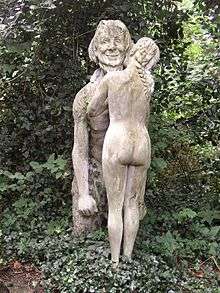Bugbear

A bugbear is a legendary creature or type of hobgoblin comparable to the bogeyman (or bugaboo or babau), and other creatures of folklore, all of which were historically used in some cultures to frighten disobedient children.[1]
Appearance
A bugbear is a humanoid, about the same height as a human, though preferring to hunt and stalk with a stoop that make it look considerably shorter and more bestial. Short, dark fur spreads all across its powerful, hulking frame. Its large ears hang loosely from its skull, and its eyes are unnaturally large - almost alien. It is not unusual for bugbears to reach nearly 7 feet in height and always weigh more than humans, some even reaching 400 pounds.
Etymology
Its name is derived from the Middle English word "bugge" (a frightening thing), or perhaps the old Welsh word bwg (evil spirit or goblin),[2] or old Scots bogill (goblin), and has cognates in German bögge or böggel-mann (goblin), and most probably also English "bogeyman" and American English "bugaboo".
In medieval England, the Bugbear was depicted as a creepy bear that lurked in the woods to scare children. It was described in this manner in an English translation of a 1565 Italian play The Buggbear.[2]
In a modern context, the term bugbear may also mean pet peeve.[3]
See also
References
| Look up bugbear in Wiktionary, the free dictionary. |
- ↑ J. Simpson, E. Weiner (eds), ed. (1989). "Raven". Oxford English Dictionary (2nd ed.). Oxford: Clarendon Press. ISBN 0-19-861186-2.
- 1 2 Briggs, Katherine M. (1976). A Dictionary of Fairies. Harmondsworth, Middlesex: Penguin. p. 52. ISBN 0-14-004753-0.
- ↑ "Definition of BUGBEAR". www.merriam-webster.com.